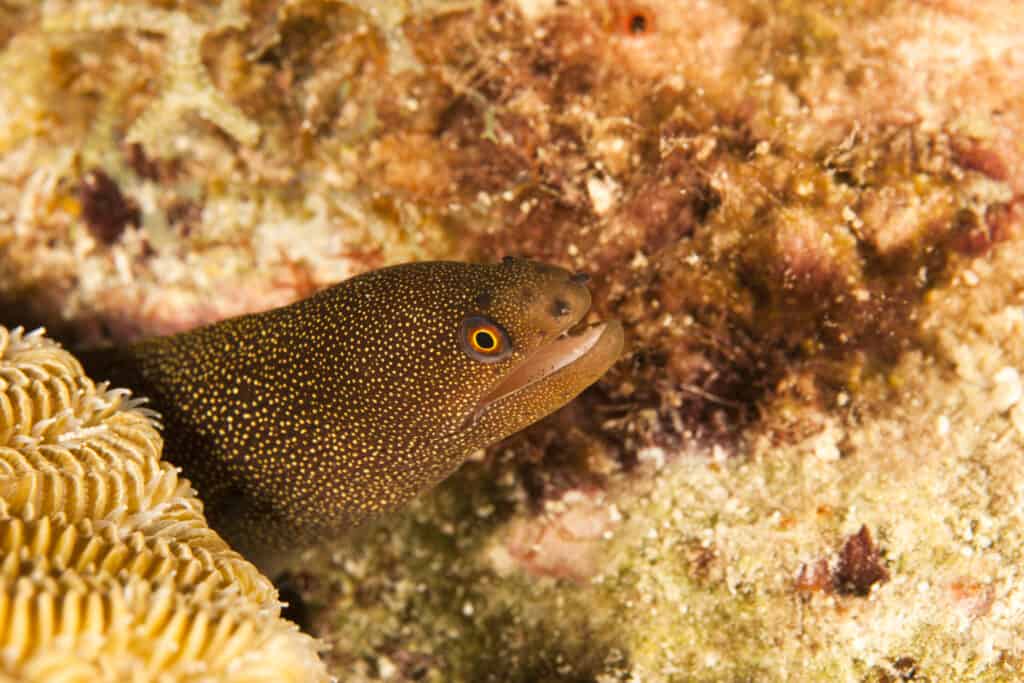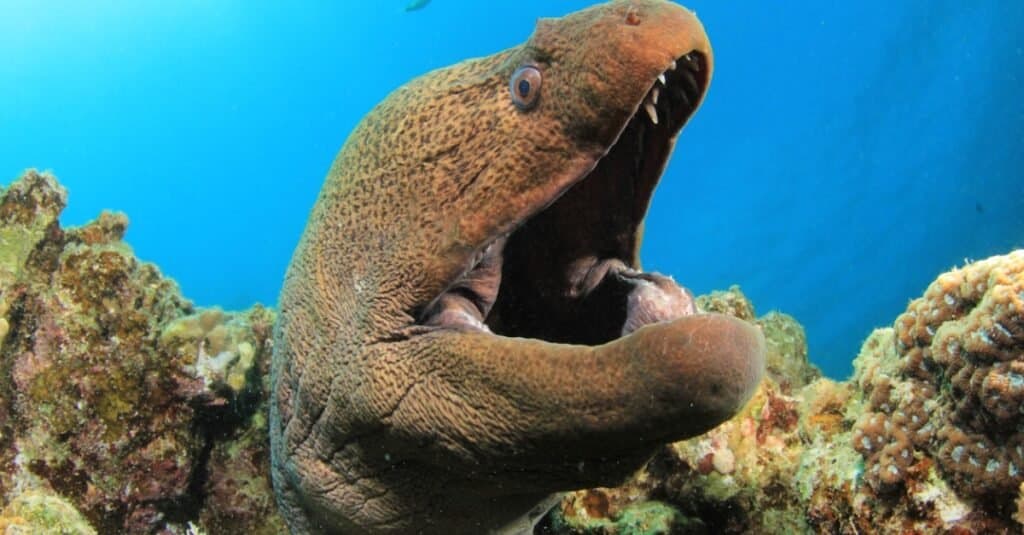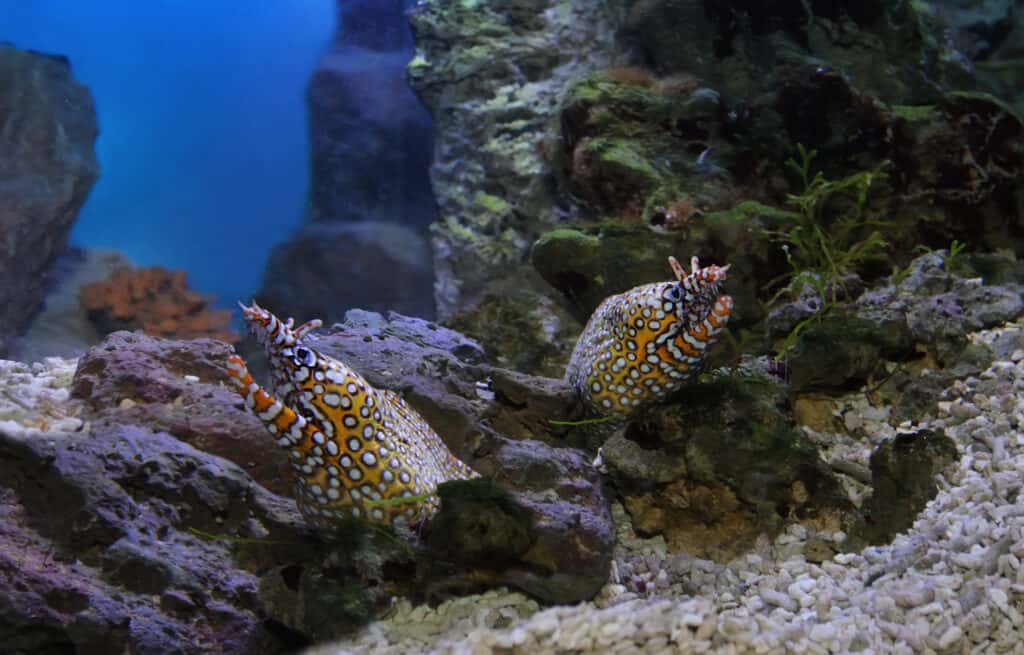Say, what? Owning a pet eel is a thing? We are here to inform you that it is!
There are estimated to be over 800 species of eels. And while their size might depend on their species, eels can weigh anywhere from one ounce to 55 pounds. In addition to that, they can reach anywhere from two inches to 13 feet!
Perhaps you’ve been thinking about going to buy a pet eel and just need that extra push. Or maybe, on the other hand, you’re thinking this is the most bizarre thing you’ve ever heard about, and by the end of this article, you’ll be wanting one!
Pros of Owning a Pet Eel

Banana eels are popular aquarium fish due to their banana-like appearance.
©Stubblefield Photography/Shutterstock.com
Before we dive into the cons of what it’s like to own an eel, let’s first set you up with success to understand the benefits involved.
Eels Have Long Lives
Eels are known for many things. They are known for their long, snake-like bodies, their inability to produce electricity (unless they are an electric eel), and for being transparent at their birth. One thing to add to the list is their long lives.
The American eel is known to be able to live up to 20 years, while the European eel is known to live over 80 years! Regardless if it is 20 or 80 years old, both numbers are impressive for a pet to live to.
One of the most difficult things to deal with in life is the passing of a beloved pet. However, with an eel being able to live such long and healthy lives, just imagine if your pet eel even outlived you! Now, let’s dive into the second pro about owning a pet eel.
You’ll Have the Most Unique Fish on the Block!
When we look at aquarium tanks and what kind of fish we might have residing in them, there are all sorts of cool fish that you could add in. You could have the unique unicorn-looking flowerhorn cichlid. Perhaps you find yourself with the dwarf puffer fish. Even still, maybe you have the very odd-looking African butterflyfish.
The above fish that we have named would surely make for a cool experience in your home aquarium. However, if you want to truly wow people with the most unique fish you could ever think of, that would be an eel.
Just imagine coming into someone’s home and seeing a beautiful large fish tank, and you’re ready to see the fish. Only you see an eel swimming around and dining on the finest shrimp. You would be sure to have the most unique fish on the block!
Cons of Owning a Pet Eel

Eels can jump out of the water.
©Rich Carey/Shutterstock.com
We’ve laid out the pros for you above in owning a pet eel. However, we would be remiss if we didn’t discuss the cons of owning one.
Eels Are Expensive
Eels are expensive in many different ways. They are expensive in purchasing the actual eel, finding a large enough tank, and then the upkeep of the animal itself.
Some eels are just over $100, which is expensive for an aquarium fish! However, the prices just skyrocketed after that. There are fish like the Golden Moray Eel that go for over $300. And then there’s the whopping Japanese dragon eel that is almost $2,000!
So, let’s say your heart ended up with a Japanese dragon eel because, hey, if you’re going to get an eel, you might as well go all out. This eel would need approximately 150 gallons of water in a tank to survive and be comfortable. And those tanks can easily run between $1,000-$2,000.
Because eels are carnivorous in their diet, they eat things such as fish, crustaceans, shrimp, crab, and even octopus would be a delicacy for them. Just because these fish are now in captivity and your tank doesn’t mean their diet will change to something less expensive. To put it quite frankly, a sole seafood diet is expensive.
Not only are eels expensive to purchase and also upkeep, they like to escape.
Eels Like to Escape
For most fish owners, we might kick back and relax and say something like, “Well, at least I won’t ever have to worry about my fish escaping.” That is unless you are the dentist in the Finding Nemo movie, where all the fish jumped out and went back to the ocean. Well, unfortunately, eels are like little escape artists. If they can get out, they will.
Christopher Scharpf of the North American Native Fishes Association provides feedback on keeping eels tightly closed up. “Do not underestimate the eel’s Houdiniesque talents…nearly every eel I’ve kept has foiled my attempts to confine it. Even when I’ve thoroughly sealed the top of the tank, I will knock something loose during feeding or maintenance or unintentionally leave the top open after feeding them before I go to bed. Given an opening, an eel will go through it.”
Summary of the Pros and Cons of Owning a Pet Eel

Dragon eels can grow up to three feet long.
©iStock.com/TatianaMironenko
| Pros of owning a pet eel | Cons of owning a pet eel |
| Long Lives | Expensive |
| Most Unique Fish | Like to Escape |
So, at the end of the day, there are pros and cons to owning an eel. And you should think long and hard before jumping into something like this. Owning an eel and owning a goldfish are two very different things.
However, in the end, people all over the world have grown great attachments to animals that other people might deem not pet-worthy. And who knows, you might just find the pet love you need from an eel that you haven’t gotten anywhere else!
The photo featured at the top of this post is © iStock.com/Miguel Angelo Silva
Thank you for reading! Have some feedback for us? Contact the AZ Animals editorial team.





